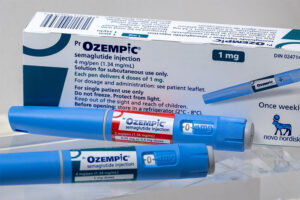
[Adobe Stock]
No longer just a diabetes company, Novo Nordisk’s semaglutide-based therapies have fueled its rise to pharma powerhouse status. From 2021 to 2023, the company cemented its position as the fastest-growing Big Pharma player, reaching a 35% year-over-year growth rate in 2023 and 74% growth from 2020 to 2023 when measured in U.S. dollars. While Pfizer saw even more explosive growth (94%) in 2021 (see second graph below), the trajectory was not sustainable leading to a 41.69% drop in 2023.
The strong demand for Novo Nordisk’s semaglutide-based products Ozempic, Rybelsus, and Wegovy fueled the company’s rapid growth. In 2023, sales of obesity care products, including Wegovy, skyrocketed by 154% to DKK 41.6 billion ($6.0 billion). The 24% sales increase in the diabetes care segment, amounting to DKK 173.5 billion ($25.2 billion) in 2023, was heavily driven by the growth of GLP-1-based products.
How Novo Nordisk revenue growth stacks up against rivals
Semaglutide sales skyrocket
In 2022, Ozempic sales surged by 77% in DKK and 61% at constant exchange rates, reaching DKK 59,750 million (USD 8.4 billion). Rybelsus also saw meteoric growth in 2022, with sales increasing 134% in DKK (114% at CER) to DKK 11,299 million (USD 1.6 billion). Additionally, The obesity care segment (including Saxenda and Wegovy) witnessed a 101% DKK (84% CER) sales jump in 2022, hitting DKK 16,864 million (USD 2.4 billion).
This momentum continued in 2023. Ozempic sales soared by 60% in DKK (66% CER) to DKK 95,718 million (USD 13.9 billion). Rybelsus sales increased by 66% in DKK (71% CER) to DKK 18,750 million (USD 2.7 billion). Most striking, the obesity care segment saw a sales increase of 147% in DKK (154% CER), hitting DKK 41,632 million (USD 6.0 billion).
Obesity epidemic stoking Novo Nordisk growth
The success of semaglutide and Lilly’s rival tirzapatide have prompted a significant uptick in obesity clinical trials, with a 68% increase from 2022 and nearly double the activity compared to five years ago.
While GLP-1s will need to overcome payer resistance and safety questions, obesity rates in much of the world continue to spiral. In the U.S., more than 40% of adults are obese. More than half of the world’s population could either be overweight or obese by 2035 with an economic impact potentially eclipsing $4 trillion by 2035, according to World Obesity.
Slimmer society, broader impact
GLP-1-based therapy could potentially lead to a slimmer society in the long run, leading analysts at Jefferies to muse that if an average passenger loses 10 pounds, airlines could save up to $80 million per year in jet fuel costs. Goldman Sachs projects GLP-1 drugs could bolster U.S. GDP by up to 1% in the coming years by curbing obesity-related health complications and improving workplace productivity. Meanwhile, some analysts see significant risk for food giants like Kraft Heinz, Hershey, Coca-Cola, and PepsiCo, leading WSJ to lament that the “Ozempic effect” on Wall Street has gone overboard.
“GLP-1s can potentially be transformative treatments, not just for obesity, not just for diabetes, but all the consequential diseases that are associated with weight and obesity,” said Murray Aitken, the executive director of the IQVIA Institute for Human Data Science. “This is going to be a very fertile area for the next decade or so.”
Transformative potential, dramatic impact
“Beyond the impact on health, Aitken predicts significant effects on other sectors: ‘the impact can be dramatic, to the extent that these drugs continue to deliver the clinical endpoints that they promise…this will be transformative on healthcare systems…individual patients…and then of course, has consequences in other sectors of life…’”
Novo Nordisk’s dominance in the GLP-1 market looks set to continue. Their ongoing development of higher-dose and more convenient semaglutide formulations demonstrates a commitment to innovation and improving patient outcomes.
To maintain meteoric growth, Novo Nordisk must navigate challenges
While it is possible for GLP-1 drugs to find use for an array of chronic diseases, Murray noted that there are several factors that could also cool the pace of adoption. “There are still side effects that affect many patients,” he said, referring to the gastrointestinal issues that some users experience. Additionally, he highlighted the need for more convenient administration options, particularly oral formulations, to improve patient adherence and acceptance.
In the positive column, a recently expanded FDA label for the obesity-targed semaglutide drug Wegovy has stoked investor interest.
But the obesity drug segment could grow more crowded in the long run. IQVIA counts 124 obesity drugs in development, dominated by GIP/GLP glucagon receptor agonists (35%). What’s more, many are oral formulations (46%) promising greater convenience. While Novo Nordisk currently has a head start, with 55% of drugs still in Phase 1 and competition heating up, the company must navigate challenges to maintain its meteoric growth.
Furthermore, the significant cost of these medications and potential resistance from payers could limit access for many patients who could benefit from these treatments. While GLP-1 therapies offer promise to treat conditions ranging from certain cancers to sleep apnea, their high price tags and the need for long-term use may present significant barriers to widespread adoption. As Murray stated, “There’s a lot to be done.”